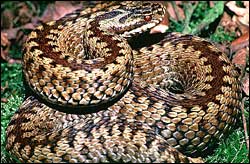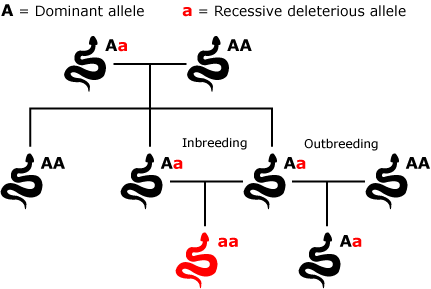
In a small population, matings between relatives are common. This inbreeding may lower the population’s ability to survive and reproduce, a phenomenon called inbreeding depression. For example, a population of 40 adders (Vipera berus, shown at right) experienced inbreeding depression when farming activities in Sweden isolated them from other adder populations. Higher proportions of stillborn and deformed offspring were born in the isolated population than in the larger populations. When researchers introduced adders from other populations — an example of outbreeding — the isolated population recovered and produced a higher proportion of viable offspring.
The explanation for inbreeding depression lies in the evolutionary history of the population. Over time, natural selection weeds deleterious alleles out of a population — when the dominant deleterious alleles are expressed, they lower the carrier’s fitness, and fewer copies wind up in the next generation. But recessive deleterious alleles are “hidden” from natural selection by their dominant non-deleterious counterparts. An individual carrying a single recessive deleterious allele will be healthy and can easily pass the deleterious allele into the next generation.
When the population is large, this is generally not a problem — the population may carry many recessive deleterious alleles, but they are rarely expressed. However, when the population becomes small, close relatives end up mating with one another, and those relatives likely carry the same recessive deleterious alleles. When the relatives mate, the offspring may inherit two copies of the same recessive deleterious allele and suffer the consequences of expressing the deleterious allele, as shown in the example below. In the case of the Swedish adders, that meant stillborn offspring and deformities.

For Swedish adders, the solution to the inbreeding depression problem was simple—introduce adders from other populations. But if the northern hairy-nosed wombat suffers from inbreeding depression, there are no other populations that can rescue it. Understanding the evolutionary history of a population and the likelihood that it carries recessive deleterious alleles, suggests that we should not allow population sizes to dip too low in our conservation efforts, or inbreeding depression may jeopardize the survival of the species.
